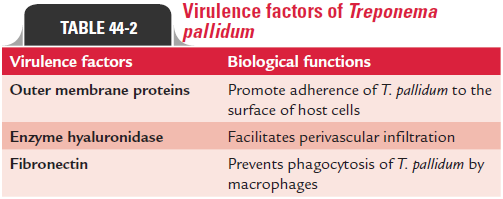Chapter: Microbiology and Immunology: Bacteriology: Treponema, Borrelia and Leptospira
Pathogenesis and Immunity - Treponema pallidum
Pathogenesis and Immunity
T. pallidum is a strict human pathogen.
◗ Virulence factors
The virulence of T. pallidum has recently been studied by clon-ing of T. pallidum genes in Escherichia coli and demonstrating

various proteins. Although many proteins have been isolated from pathogenic treponemes, the exact role of these pro-teins in pathogenesis of the disease still remains unclear. The possible virulence factors of T. pallidum include the following (Table 44-2):
1. Outer membrane protein: Outer membrane protein ofT. pallidum appears to play an important role in virulence of thebacteria. It promotes adherence of T. pallidum to the surface of host cells, thereby facilitating the infection.
2. Enzyme hyaluronidase: This enzyme, produced by onlypathogenic treponemes, may facilitate perivascular infiltration.
3. Fibronectin: Host cell fibronectin forms a coating on thesurface of pathogenic Treponema, thereby preventing it from phagocytosis by macrophages.
◗ Pathogenesis of syphilis
T. pallidum causes disease by invasion and multiplication at thesite of infection, then spreading via circulation and producing disseminated disease. Immune response of the host is believed to be responsible primarily for tissue destruction and for caus-ing pathogenic lesions observed in patients with syphilis.
On sexual contact, T. pallidum from infected partner is passed to another partner through intact mucous membrane or through minor skin abrasions. The organisms invade the skin at these lesions and multiply at the site of infection. Chancre is the primary lesion, which develops at the site of infection. Subsequently, the treponemes get transmitted in the blood stream and produce disseminated lesions (papular skin rashes, mucous patches in the oropharynx, etc.).
During the course of infection, the condition may prog-ress to the late stage of the disease and possibly all tissues are affected by T. pallidum. Every stage of the disease—whether pri-mary, secondary, or late—represents localized multiplication of the treponemes and destruction of the tissues.
◗ Host immunity
The treponemes rapidly penetrate the intact mucous membrane or minor skin abrasions and within a few hours enter the lym-phatics and blood to produce a systemic infection. Treponemal antigens induce the production of specific treponemal anti-bodies and nonspecific reaginic antibodies and relapsing fever. These also induce development of cell-mediated immunity.
Immunity in syphilis is incomplete. For example, both humoral antibodies and cell-mediated immunity prevent the formation of chancre, a primary lesion on reinfection with T. pallidum, but they do not clear the organisms from the sitesof infection. Their failure to kill the organism, possibly:
· is due to the presence of outer layer of the Treponema, which lack immunogenic molecules or
· it may be due to downregulation of helper T cells of the TH1 class.
Related Topics